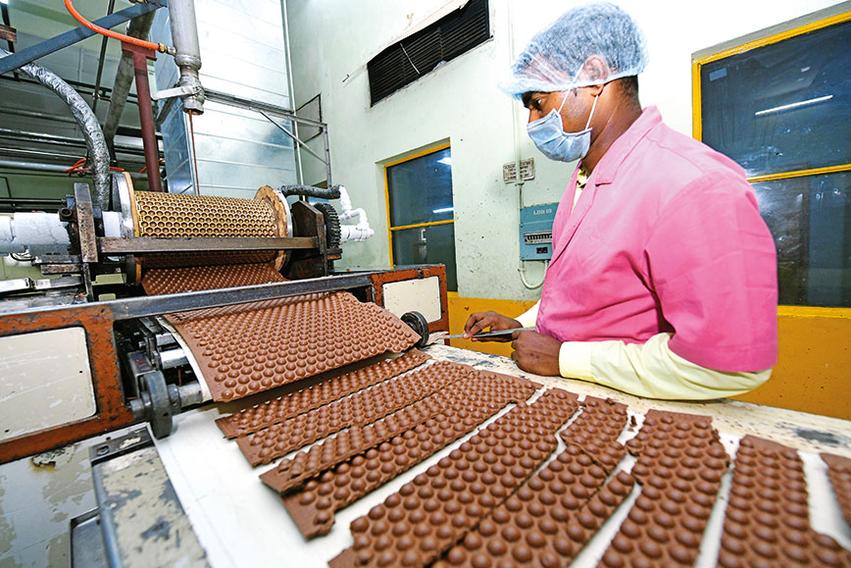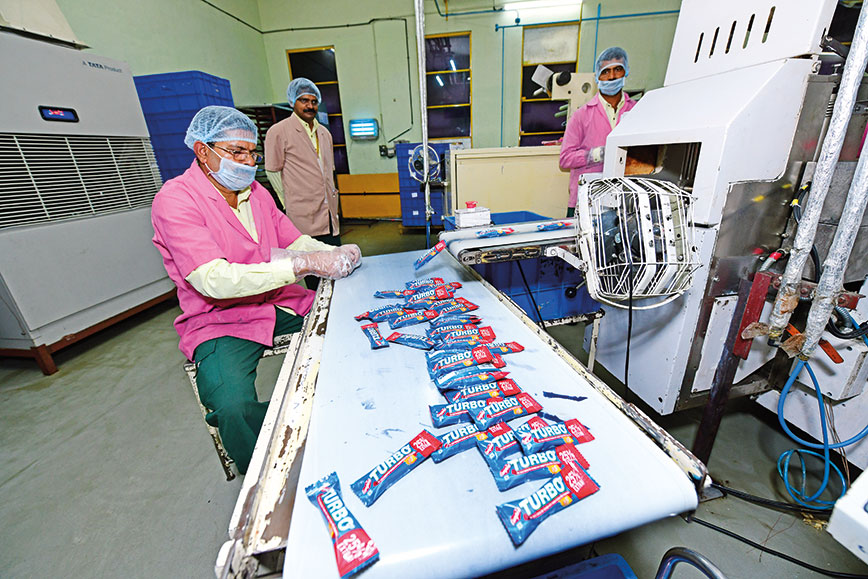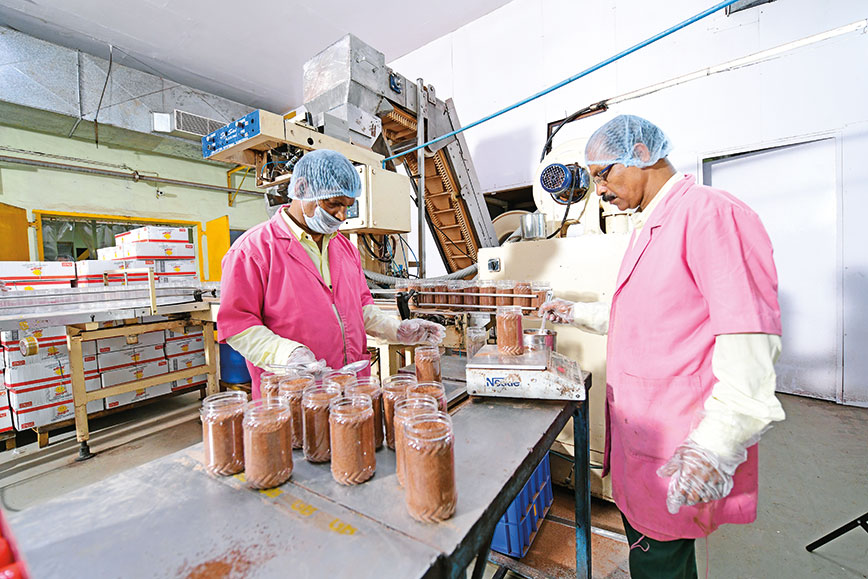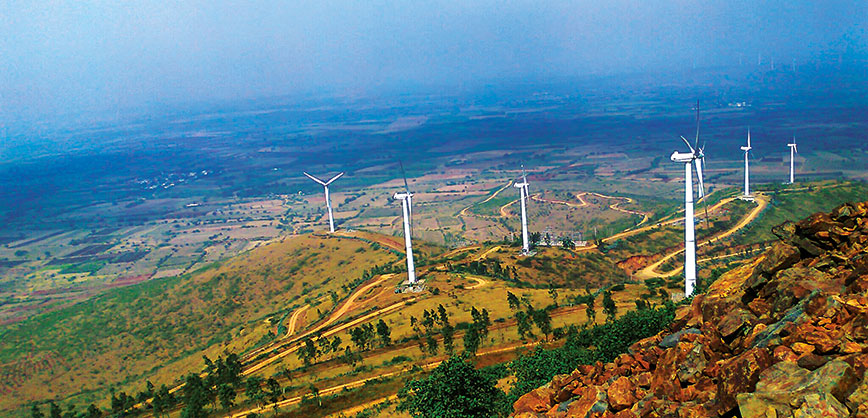
The factory is a sophisticated facility
Campco's areca nut farmers turn to chocolate
Shree Padre, Puttur
The aroma of chocolate wafts past as you drive into Koornadka, a suburb of Puttur, a town 52 km from Mangaluru in Karnataka. Follow your nose and you will arrive at the source of this seductive redolence — the Campco Chocolate Factory.
Though unknown in the north, Campco is the third biggest producer of chocolates in India after Cadbury and Nestle.
Its history is most unusual. Campco is a cooperative of areca nut farmers and stands for Central Areca Nut Marketing and Processing Cooperative. In 1986, the farmers decided to set up a chocolate factory with an investment of Rs 12 crore. The farmers knew absolutely nothing about making chocolate in those days.
Yet today their factory makes over a dozen brands of chocolate. It also manufactures chocolates for companies like Milma, KMF, Luvit and Nestle. Campco’s bestseller is a drinking chocolate which it exports majorly to Africa. In India, this drink is sold under the brand name of Winner.
Campco is also a market leader in semi-processed cocoa products which it supplies to the biggest names in the food industry — Amul, ITC, Britannia, Lotte India, Hershey's, Baskin Robbins, Vadilal, Unibic, and the Himalaya Drug Company, to name a few.
It wouldn’t be an exaggeration to say that there is a bit of Campco in nearly every biscuit, ice-cream or chocolate-infused product you bite into.
The chocolate factory did face tough times. But its parent, the areca nut unit, gamely absorbed the early setbacks. No minimum support price was required. Now the chocolate factory makes a profit and adds to Campco’s bottom line.
“Our founder president, the visionary Varanashi Subraya Bhat, understood the importance of value addition three decades ago. Farmers investing in a mammoth chocolate factory and steering it to success is an amazing initiative. There is no other industry in India that buys cocoa beans from farmers, converts it into chocolate products and markets it,” says S.R. Satishchandra, president of Campco.
Importantly, Campco plays a key role in regulating the price of cocoa beans. “Before our factory started, multinationals would reduce cocoa prices according to their whims and fancies. Whenever global prices came down, they would slash prices. This sort of irregularity stopped once we entered the market. Other companies can’t offer farmers less than what we offer. We can control the market,” says Suresh Bhandary, managing director of Campco.
Campco is today a multi-state farmers’ cooperative with a turnover of Rs 1,800 crore. Out of this the bulk comes from areca nut, but the chocolate factory contributes a significant Rs 300 crore.
The factory is a sophisticated facility. Machines have been imported from Italy, Denmark, West Germany and Switzerland. Chocolates are made without any human handling. The factory is also a tourist attraction. People come to take a look at it.
 Campco Bar, Turbo, Cream and Melto are fast movers | Photograph by Apul Alva
Campco Bar, Turbo, Cream and Melto are fast movers | Photograph by Apul Alva
COCOA IS ADDED
So how did an areca nut cooperative of farmers get into the complex business of making chocolate? To understand that we have to first turn the pages of Campco’s history.
Campco was set up in 1973 when prices of areca nut touched a record low. It was the late Varanashi Subraya Bhat, an agriculturist, who started Campco to ensure price stability for distressed areca nut farmers.
Bhat repeatedly warned the farmers not to depend only on areca nut. His suggestion was to grow intercrops like cocoa and pepper. Areca nut farmers began to grow cocoa under the shade of their areca trees.
At that time the Kerala government and Cadbury were promoting cocoa cultivation by offering plants for free. In the late 1970s, Cadbury and Amul, in a small way, were the only buyers of cocoa. In May 1980, when international prices of cocoa collapsed, Cadbury, all of a sudden, stopped buying cocoa without forewarning farmers.
In 1979, wet cocoa seeds were being bought for Rs 13.65 per kg. The next year prices slumped to Rs 5.30. After a while, buyers disappeared. The loss to the farming community was significant.
At this juncture, Campco stepped in. It began buying cocoa beans to help out farmers. But it didn’t know what to do with the huge quantities of wet cocoa beans it had bought. Campco had entered unknown terrain.
 Drinking chocolate does well in India and as an export to Africa | Photograph by Apul Alva
Drinking chocolate does well in India and as an export to Africa | Photograph by Apul Alva
Between 1980 and 1985, Campco bought 337 tonnes of cocoa beans and paid Rs 9.25 crore to farmers. It tried to sell the beans in the domestic market without much success. At that time, entrenched business interests created an impression among farmers that Indian cocoa beans weren’t good enough for making chocolate and had to be blended with imported beans.
Bhat got the beans analysed at an independent lab in France. The lab’s report clearly said that the Indian beans were on a par with international standards. This endorsement helped Campco export 164 tonnes of its beans and earn Rs 3.64 crore. “This was the first ever export of Indian cocoa beans. It helped wipe out the wrong notion internationally that our cocoa beans were inferior,” recalls K. Ganapathy, deputy general manager, accounts, at Campco.
It then occurred to Campco that the best way of doing justice to its beans was by starting a chocolate factory. No one in the cooperative knew anything about making chocolate. But the board and a few farmers endorsed the decision though Bhat was being severely criticised for venturing into uncharted waters.
In 1986 Campco’s chocolate factory was inaugurated by the then President of India, Giani Zail Singh. With its investment of Rs 12 crore, Campco’s factory at that time was the biggest chocolate factory in Asia.
“Campco learnt everything the hard way,” says A.S. Bhat, former managing director. “The institution had to undergo hardship and losses to support cocoa farmers. Overcoming all technical problems, Campco exported dry beans in those years, a testimony to its dedication and hard work. In fact, after Campco ventured into cocoa it never ever let the farmers down.”
Campco was again tested two years ago when the international market crashed due to over-supply of cocoa beans. Buyers vanished. But not Campco. The price of cocoa beans nosedived to around Rs 35. Before the crisis Campco was buying beans for Rs 50 to 60 per kg. It stuck to Rs 50 and ended up buying 3,000 tonnes in two months, a quantity it would have bought in an entire year under normal circumstances.
Processing and drying mountains of beans was tough. The wet beans had to be rushed to Darapuram in Tamil Nadu and Sira in Tumkur for drying. Around three kg of wet beans are required to make one kg of dry cocoa beans.
But Campco’s farmer-friendly stand turned out to be a boon. The very next year global prices touched Rs 73 per kg. Campco had a stock of 1,200 tonnes of dry beans which it had bought for Rs 50 per kg as wet beans. The company made money thanks to this stockpile. The profit helped its financials for two years.
“During our meetings with cooperative societies, many farmers openly acknowledge that it is only because of Campco’s support that they have retained cocoa cultivation,” says Bhandary.
 NESTLE PACT
NESTLE PACT
Bhat’s tenure ended in 1990. But before he left, he signed a 10-year agreement with Nestle under which the multinational would manufacture its chocolates at the Campco factory. Many old-timers say this was another visionary step he took.
“By using the factory’s surplus capacity, it was steered to viability,” says S.R. Rangamurthy, former president of Campco.
Between 1987 and 1990, Campco was manufacturing its own products but it had surplus installed capacity at its factory. To augment revenue, in 1990, Campco offered their facility on lease to Nestle. At that time Nestle wasn’t producing chocolates in India but it was planning to. The Nestle team surveyed the Campco factory and signed a 10-year lease.
The agreement was wisely drafted. It said that if Nestle did not use the entire stock it had agreed to lift, it would have to pay a commitment charge to Campco. Secondly, Nestle had to buy cocoa beans only from Campco. “If these two clauses had not been included, Campco would not have gained so much. Nestle could have imported cocoa,” says Bhandary.
From 1990 to 1997, Nestle produced all their chocolates at the Campco factory. Later they started their own unit at Ponda in Goa. Yet, the goodwill between the two is such that Nestle still gets some products made at Campco.
Both the Kerala and Karnataka governments had invested Rs 37.5 crore in Campco’s areca nut wing in 1973. Therefore, the managing director was nominated by Karnataka and the secretary by Kerala. The downside was that taking timely farmer-friendly decisions became difficult for the board.
So, in 2005, Campco repaid the share capital of both state governments and nominated their own managing director. The first to be appointed in this way was Madhusoodan Rao Perodi. “It was during my tenure that the Campco chocolate factory began making a profit,” he says.
At that time Campco was under considerable pressure to sell its loss-making chocolate factory to an MNC. Members were worried that money from areca nut was being used to fund the chocolate factory.
S.R. Rangamurthy, president of Campco, appealed to the board to give him a year to find a solution. Demand for semi-processed cocoa products — cocoa mass, cocoa butter and cocoa powder — was rising. After brainstorming it was decided to prioritise production and marketing of semi-processed cocoa products. This decision turned around the fortunes of the chocolate factory.
The semi-processed chocolate products bring the most business to Campco. The chocolates it sells as its own brands are secondary. In the past five years the company has sold semi-processed products more than double the weight of its chocolates. In 2017-18, for instance, it sold 1,683 tonnes of its own branded chocolates valued at Rs 48.65 crore while sales of semi-processed products touched 6,352 tonnes and were valued at Rs 134.66 crore. In addition it produced 5,666 tonnes of chocolates for other companies as job work. Totally it produced 13,701 tonnes of chocolate, earning a profit of Rs 2.72 crore.
The chocolate factory's account is finally clubbed with the accounts of the acreca nut, pepper and rubber divisions. Taken together, Campco's turnover in 2017-18 was Rs 1,743 crore and its profit was Rs 46 crore, which includes the Rs 2.72 crore from chocolates.
Till 2007, Campco was content with average sales of Rs 5 crore from semi-processed cocoa products. But it noted that use of chocolate was increasing by 25 percent every year and the demand for customised cocoa products was also going up.
“Apart from our three basic cocoa products we now make at least 50 cocoa products. We have seven to eight types of chocomass which is used in ice-cream. In dark chocomass we make eight types. And we have seven types of milk chocomass,” says Prabhakara Holla S., product manager for planning and semi-finished products.
Campco provides semi-processed cocoa products in specific customised form to the food industry. For instance, it makes chocolate in liquid form for Lotte, an MNC which manufactures Choco Pie, a biscuit coated with chocolate. Cocoa in slab form would cost the company Rs 4 more per kg.
Campco also makes white chocopaste for chocolate paan, a new innovation that’s now popular in Mumbai and Ahmedabad. A paanwallah from Mumbai buys five tonnes of white chocopaste every month from Campco. He gets orders in advance for chocolate paan for weddings in rich families.
Another product Campco retails is industrial chocolate in half-kg and one-kg slabs. Most clients are artisanal chocolate makers in Madikeri, Ooty and other tourist areas. They melt the slab, mix their own additives, reshape the chocolate and sell locally.
Campco also makes chocolate chips. It recently imported a cocoa chips making machine from Turkey. The machine can churn out seven tonnes of chips per day.
Explains Anitha Jesumas, AGM, Industrial Cocoa Products, “South India is our main target for semi-processed products. Transportation costs to north India are very high. About 175 institutional buyers buy different types of semi-processed products from us. Trends are changing. Earlier, industrial
slabs were much in demand. Now everyone wants this too in further ready form. That’s how the biscuit industry started preferring cocoa chips.”
 Campco kiosk: Retail outles are few and marketing hasn't been a strong point
Campco kiosk: Retail outles are few and marketing hasn't been a strong point
MARKETING SNAGS
Campco has 12 brands of chocolates. It has an annual turnover of Rs 36 crore out of which 60 percent comes from the four south Indian states of Kerala, Karnataka, Tamil Nadu and Andhra Pradesh.
The general impression is that the chocolates are good but they are not promoted aggressively. Campco hasn’t been able to enter the premium chocolate segment. Their main market is farmers and rural areas.
In the chocolate industry, marketing centres are divided into A, B and C class outlets. Big cities and malls are considered A class outlets. Bakeries are categorised as B class while C class denotes rural areas. “We could reach only B and C class outlets. In fact, most of our clientele is in C class,” explains Bhandary. “This is because no other company has reached out to this class. We reached the B segment only after a series of advertisements in the media.”
Out of the dozen chocolates it makes, Campco Bar, Turbo, Cream and Melto are fastmovers. In fact, the credit for introducing Cream, a white chocolate, to India goes to Campco which introduced it in 1987. Till then, white chocolates were imported.
Campco has made attempts to enter the A class market. Last year it introduced Dietier, a sugar-free dark chocolate for diabetics, made with maltitol, a sweetener which doesn’t raise blood sugar level.
“Health-conscious women generally restrict eating chocolates and ice-cream. Dietier doesn’t cause weight gain. Whoever tastes Dietier asks where it is available in the city. But it isn’t available at all outlets. Though it has potential, unfortunately, we couldn’t market it at that level,” says Bhandary.
Another interesting chocolate that Campco invented in partnership with the Central Plantation Crops Research Institute (CPCRI) in Kasaragod is called Kalpa. It is made with sugar called Kalpasara which is extracted from coconut palm. Kalpasara has low glycemic index and is suitable for diabetics. The chocolate has a slight caramel taste.
“People liked the taste. But we could not continue producing it. The supply of Kalpasara is erratic and its price is high so the production cost goes up. Customers find Rs 100 for a 60 gm chocolate too expensive. We had to create consumer awareness about the chocolate’s health aspects. We couldn’t place it in our normal retail market. So we have temporarily discontinued making it,” explained Bhandary.
Another dark chocolate called Fun Tan has also been well received. These three chocolates are all premium ‘pure chocolates’ say insiders in Campco because cocoa butter is used. They are also more expensive since cocoa butter costs Rs 550 per kg.
Most of Campco’s inexpensive chocolates use vegetable fat and are called ‘compound chocolates’. Vegetable fat costs around Rs 120 per kg. Another reason for using vegetable fat is that chocolates with cocoa butter melt easily but those with vegetable fat don’t.
“Our major setback is that we don’t get the top retailers to stock our chocolates. We have to settle for next in line professionals,” says Bhandary.
“We also realised that we have made some mistakes. We sold chocolates worth Rs 36 crore this year. Three years ago, we sold chocolates worth Rs 67 crore. We upgraded our products. Yet our turnover went down. Why?”
A GREEN FACTORY
Campco realised the importance of green energy early on. For over a decade it has been generating electricity from windmills located hundreds of kilometres away in north Karnataka’s Hoovinahadagali and Chikkodi districts. Through a wheeling arrangement, Campco is able to use wind energy in its Puttur factory. Out of its annual requirement of 68 lakh units, 75 percent is met by wind energy. The rest is drawn from KSEB. Suresh Bhandary, managing director, says Campco saves `10 lakh per month by using wind energy. It costs `3.40 per unit whereas conventional electricity from KSEB costs double at `6.80 per unit. Campco requires about 40 to 60 tonnes of steam per hour. Steam generation is very expensive. Conventional furnace oil was being used for the boilers. The price of furnace oil fluctuates, depending on the international price of crude oil. In 2000, Campco changed to bio-fuel boilers which run on briquettes, then priced at `3 per briquette. Now briquettes cost `5. Switching to bio-fuel boilers is saving the company `1.2 crore annually. Campco was also paying a lot for electricity for its air conditioners. The company switched to VAM — Vapour Absorption Mechanism — which creates air conditioning by using steam. Now their entire air conditioning requirement is met by two VAM units installed three years ago. The company saves `1.38 crore per annum on electricity charges. The chocolate industry needs lots of water too. Campco's daily requirement is 300,000 litres. For over a decade they faced acute water stress. Each bore well would run for two or three years and then go dry. Only three bore wells out of the 13 they had yielded water. They were afraid they would have to stop production. A tanker was bought and kept ready to ferry water from outside. In the past four years the story has changed. In 2015, they dug a large pit and diverted all rooftop rainwater to it. The results were positive. So they intensified their groundwater recharge efforts. M. Avinash Rai, AGM, engineering, explains, “We now have four rainwater percolating points. Two are huge ponds. Rainwater doesn’t flow out of our 13.5 acres. Rain falling on our 8,500-square-metre roof area is also channeled for recharging. Water from the rooftop alone yields 30 crore litres which meets our needs for 100 days.” Now the tanker is diverted for other work. Many small industry owners have visited Campco and adopted some of their green technologies. |
Three years ago the company spent Rs 1.5 crore to advertise its chocolates on TV channels which children watched like Pogo and Disney. Then issues of cost control cropped up. It was decided that the company would spread their advertisements across regions, a move that proved counterproductive.
The second mistake was to stop giving credit to retailers. Due to the credit facility, sales representatives promoted Campco products, showcasing them prominently to get the money back. That facilitated better sales.
“We have to advertise strategically and develop our brand by employing impressive brand ambassadors,” says Francis D’Souza.
It is surprising that Campco hasn’t been able to create a stronger brand identity. The company has only three kiosks, one each on the factory premises at Puttur, Puttur city and Bengaluru. The kiosks offer 20 percent discount and are earning Rs 5 to 6 lakh per month without publicity.
Campco also hasn’t capitalised on its popularity among the farming community. It was only after farmers complained they weren’t being able to buy Campco chocolates that the company installed refrigerators with chocolates at 22 retail stores. Recently, in a single day, Rs 35,000 worth of chocolates was sold from a store. So Campco could tap into the rural market and offer to supply chocolates to farmers for weddings and other functions.
It is tapping a marketing opportunity at its factory premises. Campco now charges Rs 50 per visitor and gives a Rs 50 pack of chocolates to each person. In this way, the company’s products reach households.
Campco employs a dedicated staff of 250 including about 150 ITI graduates. Another 350 work on contract basis in the packaging section. “The ITI graduates were unemployed. We trained them and put them to work. They wouldn’t have got this opportunity in Bengaluru,” says Bhandary.
So far Rs 89.77 crore has been invested in the factory. Around Rs 65.88 crore was spent buying machinery. Out of its total crushing capacity of 4,200 tonnes of dry cocoa beans per annum, the factory is now grinding 3,600 tonnes. In the last 10 years, Campco made an average profit of Rs 3.89 crore per annum. They made a loss only one year.
“We shouldn’t forget that Campco’s sole objective isn’t only to make profits,” clarifies Rangamurthy. “We have to see to the interests of our farmers and stabilise cocoa prices. This is what makes Campco’s job more challenging.”
Satishchandra says the success of the chocolate factory has given them confidence. They are now planning to venture into coconuts.
“We will start a coconut factory shortly. Our plan is to utilise 100,000 coconuts per day in three shifts. We intend to make a big range of products, out of which 60 percent will be for export,” he says.
Contact Campco Chocolate Factory: (08251) 230207; email: [email protected]
Comments
-

Dr K G Bhat - May 1, 2019, 8:34 p.m.
I hail from a farmer's family that grows coco as inter crop in Arecanut farm. Back in the eighties the main buyers were Cadbury India that refused to buy at a time when arecanut market was also not very profitable.It was then that Sri.Varanashi Subraya Bhat took the initiative to buy wet coco beans and process them which later materialized into chocolate production. It was a huge risk as Cadbury chocolates dominated the market. Undeterred, Campco chocolates slowly started picking up sales. Today it has grown into a large chocolate manufacturer managed by farmers themselves and we are glad!!
-

Narendra M Apte - May 1, 2019, 4:05 p.m.
This is a very good news story about success of a cooperative . I wish that CAMPCO becomes a household name in years to come.




